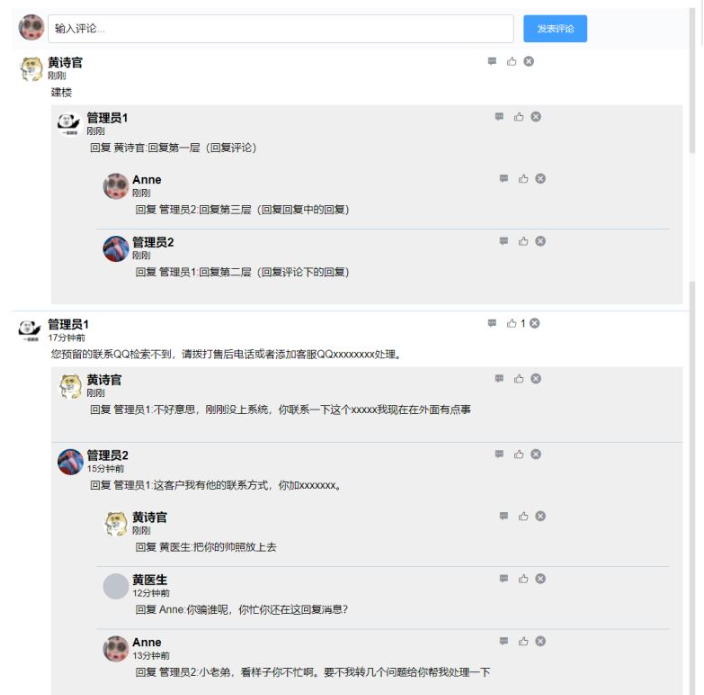
總共是兩層回覆(回覆留言、回覆留言下的回覆)
#評論表(TFW_Comments)和回覆內容表(TFW_UserResponse)以及評論回覆關係表(TFW_MsgRelation)
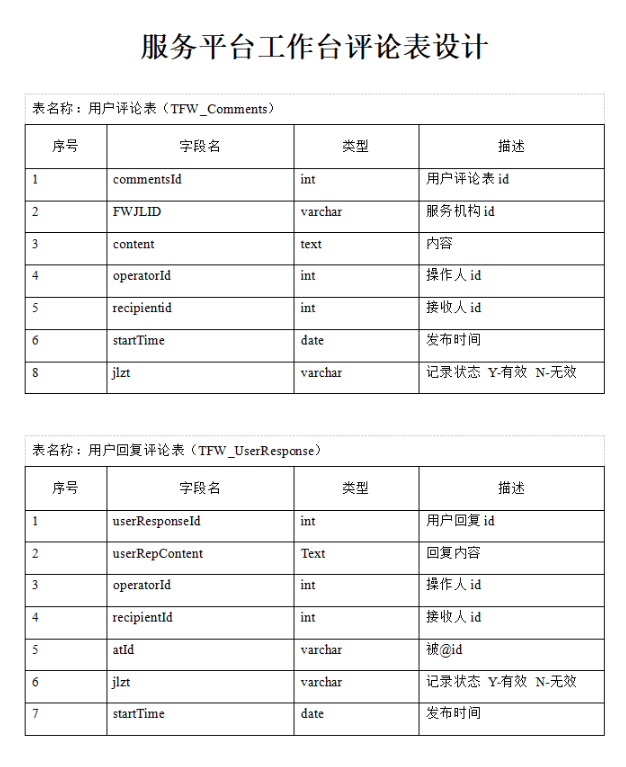
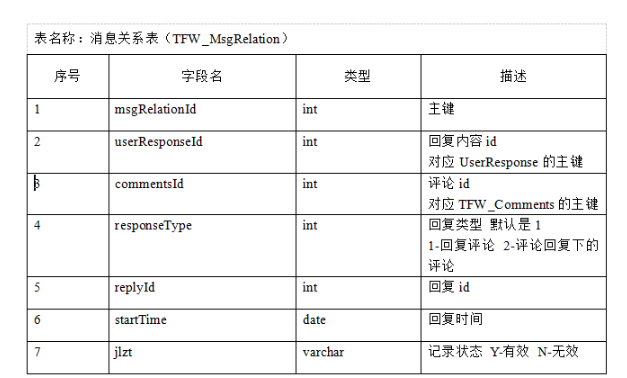
註:各位讀者自動忽略評論表的服務機構ID字段,這個字段相當於這條評論是在哪個帖子(文章下面)
1、根據文章ID或者是帖子ID查詢評論表取得評論(本文的服務機構ID)。第一層(評論)
取得第二層回覆(commentsId),需要根據評論ID且回覆類型等於1,在關係表中查詢。第二層(評論下的回覆)
根據評論ID、回覆類型為2、以及回覆ID在關係表中取得第三層回覆資訊。第三層(評論下回覆中的回覆)註:回覆ID是它的上級
@Override
public Map<String, Object> findComments(JSONObject jsonObject) {
data.clear();
String userId = jsonObject.getString("userId");
String role = this.role(jsonObject);
if (role.equals("-1")){
//没有权限
data.put("error","-1");
data.put("msg","当前用户没有权限");
return data;
}
List<Map<String, Object>> info = commentsDao.findComment(jsonObject.getString("fWJLID"),null);
//查询点赞次数
int countTag = 0;
MsgRelationTag msgRelationTag = new MsgRelationTag();
for (Map item : info){
item.put("inputShow",false);
int commentsId = (int) item.get("commentsId");
//查询点赞次数
countTag = msgRelationDao.findCountTagByTagId(commentsId,1);
item.put("countTag",countTag);
//设置点赞状态
msgRelationTag.setTagId(commentsId);
msgRelationTag.setTagType(1);
msgRelationTag.setTagUserId(Integer.parseInt(userId));
MsgRelationTag msgTag = msgRelationDao.findMsgTag(msgRelationTag);
if (msgTag != null) {
item.put("tagStatus",msgTag.getStatus());
}else {
item.put("tagStatus","");
}
//如果有@id
if (item.get("atId") != null){
String content = item.get("content").toString();
StringBuffer tmrAtId = findUserName(item.get("atId").toString());
item.put("content",content+'@'+tmrAtId);
}
//二级回复数据
List<Map<String, Object>> twoReply = new ArrayList<>();
//所有数据
List<Map<String, Object>> userResponse = userResponseDao.findUserResponse(commentsId, null, "","",null);
for (Map userResponseInfo :userResponse){
int userResponseIds = Integer.parseInt(userResponseInfo.get("userResponseId").toString());
//查询点赞次数
countTag = msgRelationDao.findCountTagByTagId(userResponseIds,2);
//设置点赞状态
msgRelationTag.setTagId(userResponseIds);
msgRelationTag.setTagType(2);
msgTag = msgRelationDao.findMsgTag(msgRelationTag);
if (msgTag != null) {userResponseInfo.put("tagStatus",msgTag.getStatus());}else {userResponseInfo.put("tagStatus","");}
userResponseInfo.put("countTag",countTag);
userResponseInfo.put("inputShow",false);
Integer responseType = (Integer) userResponseInfo.get("responseType");
for (Map stairReplyInfo : userResponse){
Integer userResponseId = (Integer) stairReplyInfo.get("userResponseId");
int msgRelationId = Integer.parseInt(stairReplyInfo.get("msgRelationId").toString());
//接受者id*/
twoReply = userResponseDao.findUserResponse(msgRelationId, userResponseId,"1","",null); //二级回复数据
for (Map twoReplyItem : twoReply){
int twoReplyId = Integer.parseInt(twoReplyItem.get("userResponseId").toString());
twoReplyItem.put("inputShow",false);
//查询点赞次数
countTag = msgRelationDao.findCountTagByTagId(twoReplyId,2);
twoReplyItem.put("countTag",countTag);
//设置点赞状态
msgRelationTag.setTagId(twoReplyId);
msgTag = msgRelationDao.findMsgTag(msgRelationTag);
if (msgTag != null) {twoReplyItem.put("tagStatus",msgTag.getStatus());}else {twoReplyItem.put("tagStatus","");}
String userRepContent = twoReplyItem.get("userRepContent").toString();
if (twoReplyItem.get("tmrAtId") != null){
StringBuffer tmrAtId = findUserName(twoReplyItem.get("tmrAtId").toString());
twoReplyItem.put("userRepContent",userRepContent+'@'+tmrAtId);
}
}
stairReplyInfo.put("twoReply",twoReply);
}
}
item.put("stairReply",userResponse);
}
data.put("data",info);
data.put("error",0);
data.put("msg","查询成功");
return data;
}其它的程式碼可以忽略。主要語句有:
List<Map<String, Object>> info = commentsDao.findComment(jsonObject.getString("fWJLID"),null);上圖根據FWJLID取得評論。 (這裡可以當成帖子的ID,獲取帖子下的評論)一級展示
對應SQL語句(OPT是我的用戶表)
select tc.content ,tc.commentsId,convert(varchar(19),tc.startTime,120) as startTime,tc.recipientId ,tc.operatorId,zo.NAME as operatorName,tc.atId,zo.HeadImgUrl as operatorHeadImgUrl
from TFW_Comments tc
left join zd_opt zo on zo.AID = tc.operatorId where tc.FWJLID = 5101查詢結果:

List<Map<String, Object>> userResponse = userResponseDao.findUserResponse(commentsId, null, "","",null);
上圖根據commentsid取得評論下的回應。 (根據評論ID取得回應)二級展示
對應sql語句
select
tur.userResponseId,tur.operatorId,tur.recipientId,convert(varchar(19),tur.startTime,120) as startTime,tur.userRepContent,tmr.atId as tmrAtId,
tmr.msgRelationId ,tmr.responseType,tmr.replyId,
zo.NAME as operatorName,
zo1.NAME as recipientName,
zo.HeadImgUrl as operatorHeadImgUrl,
zo1.HeadImgUrl as recipientHeadImgUrl
from TFW_MsgRelation tmr
left join TFW_UserResponse tur on tur.userResponseId = tmr.userResponseId
left join zd_opt zo on zo.AID = tur.operatorId
left join zd_opt zo1 on zo1.AID = tur.recipientId where tmr.commentsId = 47查詢結果

twoReply = userResponseDao.findUserResponse(msgRelationId, userResponseId,"1","",null); //二级回复数据
select
tur.userResponseId,tur.operatorId,tur.recipientId,convert(varchar(19),tur.startTime,120) as startTime,tur.userRepContent,tmr.atId as tmrAtId,
tmr.msgRelationId ,tmr.responseType,tmr.replyId,
zo.NAME as operatorName,
zo1.NAME as recipientName,
zo.HeadImgUrl as operatorHeadImgUrl,
zo1.HeadImgUrl as recipientHeadImgUrl
from TFW_MsgRelation tmr
left join TFW_UserResponse tur on tur.userResponseId = tmr.userResponseId
left join zd_opt zo on zo.AID = tur.operatorId
left join zd_opt zo1 on zo1.AID = tur.recipientId where tmr.commentsId = 136 and tmr.replyId = 155
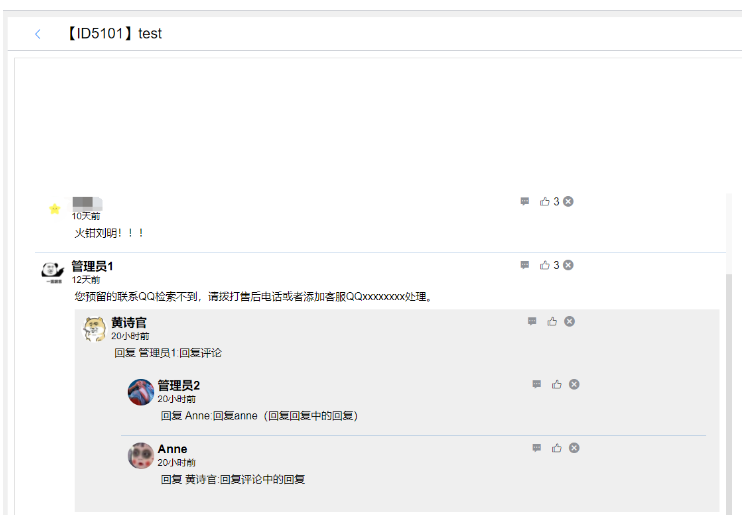
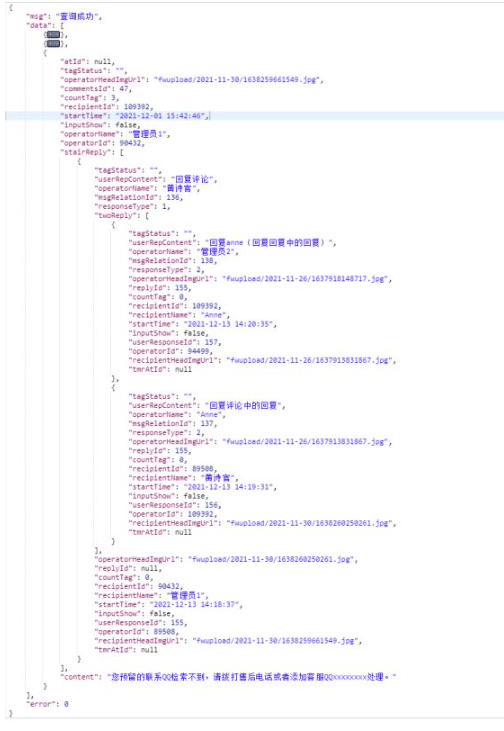
以上是java怎麼實現評論和回應功能的詳細內容。更多資訊請關注PHP中文網其他相關文章!




